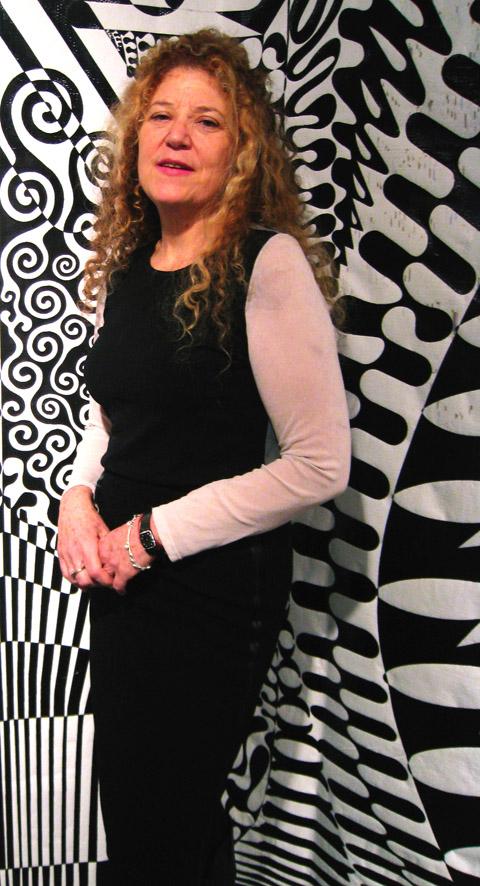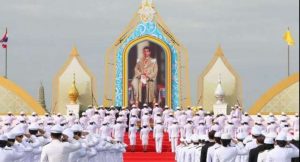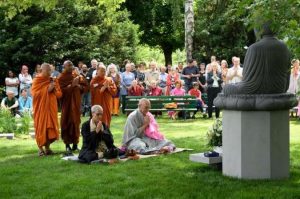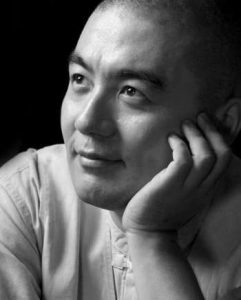*
“What used to be done by Religion has to be done alone by Art.”
– Saburo Hasegawa, in a letter to Isamu Noguchi.
January 12, 1951.
*
Zen and avant-garde is a curious union, both of which Ellen Pearlman is in a superb position to explain. Unfortunately, my review of her new book doesn’t boast the insight of an avant-garde critic. I find it difficult to write as a journalist and as a postmodern artist at the same time, because I’m not an artist. By contrast, Nothing and Everything is a book more about art than religion and presupposes a decent knowledge or interest in American avant-garde. Despite this, one “credential” I do have is that I’m a Buddhist and someone who publicly writes about Buddhism. So I probably do have a small stake in understanding the New York collaboration between Saburo Hasegawa, the first Japanese abstract painter, the Japanese-American sculptor Isamu Noguchi, and Franz Kline the European-American painter. Their triumvirate is only one story of many that Pearlman offers, but with such a phenomenon as complex as avant-garde, it is easy to see which stories involve themselves with a transcendent philosophy in its Japanese form.
Nothing and Everything is a postmodern smorgasbord of ideas. There are six fleshy and eloquent chapters in this book, chronologically tracing the trajectory of the Buddhist influence on avant-garde. The detail of not only the people but also their personalities is terrific, and it wouldn’t be right or helpful to list many here. Suffice to say that it begins, as so many others do, with Daisetsu Teitaro Suzuki, the gentleman who laid the philosophical and spiritual foundations of an American understanding of Zen. He came to America and his ideas rapidly took root. His role in the creation of Buddhist “modernism” or “postmodernism” has been highlighted in many other books before Pearlman, although she articulates better than anyone why he exercised such an immense authority over American ideas about Zen and its subsequent influence over avant-garde.The chapters after Suzuki center on Western and Japanese figures that utilized their experience of Zen in a unique way to craft their art, from John Cage to the Beat generation.It must be remembered that avant-garde is not only a school of art, or a way of making and seeing art, but also a movement, an intellectual phenomenon that began with a reorientation to the ephemeral moment shortly after 1945. Avant-garde, as I understand it, arrests the viewer with a piece of present-centered artwork. It cannot be
but arresting, because the monkey mind of Zen is warned to be restless, lost in a world of senses and ideologies. The convergence of Zen and avant-garde came about as disillusioned Americans scrambled to affiliate themselves with Zen, while young Japanese were distancing themselves from it due to its historical association with nationalism and imperialism. The question courses through Pearlman’s pages: what kind of meeting was possible when both sides were running away from baggage they needed to come to terms with?
Throughout the book Pearlman draws connections between the premises of Zen and avant-garde, quoting from direct sources. By 1959, Zen was intimately known in avant-garde circles in New York, particularly through the work of The Club’s publications and activities. See, for example, Cage’s performance of 4’33” as 0’00” in Japan in 1962, or how the Judson Dancers invoked Zen notions of “attending to the ordinary” to choreograph extraordinary movements. My favorite account was of the friendship between Hasegawa and Noguchi. Their main contact was through calligraphy and poetry, and its echoes with Western art. It reflected their own tension with their American and Japanese heritage, their own attempt to come to terms with the stylistic inclinations of their work.
With respect to Buddhism, Pearlman remains fairly impartial and does not presume to judge the validity of this East-West cultural intermingling – just look at the doctrinal shakiness Ginsberg was precariously tottering into, despite his formal refuge-taking in the Buddha. The shadow of orientalism is weak in her book. Her concern is for artists, and artistic license allows for greater cultural appropriation than other disciplines. I grew up in the 1990’s and the new millennium, and with the turn of the twenty-first century comes a time in which Buddhists are a lot more careful about what should be seen as “Buddhism” and what is a misguided appropriation of its traditions. But this is not Pearlman’s overarching concern, nor should it be. Her objective is to tell the story of rebellious Zen and subversive avant-garde, and it rightfully challenges us as a fantastic multiplicity of journeys. The world that Pearlman crafts through eloquent narrative and researched rigor is vivid and lively. It was hard not to see myself standing before the protagonists of her evocative narratives, watching Kline poring excitedly over issues of the calligraphy and painting journal, Bokubi. This was the beginning of another story about Hasegawa, Noguchi and Kline’s exploration of traditional Japanese and modern art.
Art and faith, form and spirituality, are two forces that people still struggle to articulate, to grasp, and to share. The task remains as difficult as ever. Only now in 2012 can an author of Pearlman’s high standards show us how Zen influenced the American avant-garde movement. How far have we come, where are we now, and in what directions are we headed in our respective crafts? The big question of our “post-postmodern” zeitgeist is, “What do we have after gaining everything?” Many might still say we have nothing. We’re back at square one. The contemporary period, particularly movements like modernism, oversaw the death of true art, as some nostalgia-prone scholars like Christopher Beckwith lament.
For more spiritual artists and certainly Buddhists, we have more solid foundations on which we continue to build. I can’t speak for artists, but Buddhists are all about building communities of compassion. I believe visual aesthetics, dance, poetry, and music are coming to influence the Buddhist community just as much as Bodhidharma and the vision of “open consciousness” inspired Group Ongaku. The trick, I think, is to understand where their intersection, their crossroads, lies.
Listen to a Podcast interview with Ellen:
Link to Rubin Museum of Art Book Launch:














